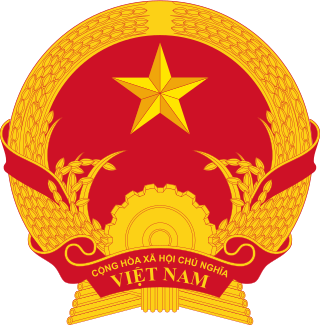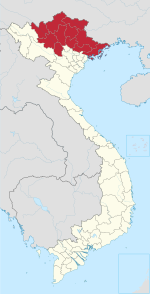
Vietnam is divided into 63 first-level subdivisions, comprising fifty-seven provinces and six municipalities under the command of the central government. Municipalities are the highest-ranked cities in Vietnam. Municipalities are centrally-controlled cities and have special status equal to that of the provinces.
Articles related to Vietnam and Vietnamese culture include:

Ninh Bình is a province of Vietnam in the Red River Delta region of the northern part of the country. The province is famous for a high density of natural and cultural attractions, including reserved parks in Cúc Phương National Park and Vân Long, grotto caves and rivers in Tràng An, Tam Cốc-Bích Động and Múa Caves, historic monuments in the Hoa Lư ancient capital, Vietnam's largest buddhist worshiping complex, and the Phát Diệm Cathedral with "eclectic architectural style". Thanks to its adjacency to Hanoi, day trips from the capital are easily manageable.

Hải Dương is a city in Vietnam. It is the capital of Hải Dương, an industrialized province in the Hanoi Capital Region and the Red River Delta in Northern Vietnam. The city is at the midpoint between the capital Hanoi and the major port Haiphong, and is part of the Northern Key Economic Zone. In 2019, Hai Duong city had a population of 241,373.

Cẩm Phả is a city of Quảng Ninh Province in the Northeast region of Vietnam.

Cầu Giấy is an urban district of Hanoi, the capital city of Vietnam. It is located roughly to the west of urban Hanoi. Cầu Giấy has a unique urban landscape, with new urban developments interlacing old historical artisan villages. The most well-known of them is a cluster of Dịch Vọng villages with its popular cốm dessert.
The 3rd Military Region of Vietnam People's Army is directly under the Ministry of Defence of Vietnam, tasked to organise, build, manage and command armed forces defending the Red River Delta. The north-West region of Vietnam borders with the Guangxi, China. In 1979, Chinese army with one infantry division, launched an invasion in this military zone.

The 11th Central Committee of the Communist Party of Vietnam was elected at the 11th National Congress of the Communist Party of Vietnam. The 11th Central Committee elected the 11th Politburo and the 11th Secretariat.

On 27 January 2016, the 12th National Congress elected 180 individuals to serve as members of the 12th Central Committee of the Communist Party of Vietnam (CPV) for the electoral term 2016–2021. The Central Committee is the highest decision-making institution in the CPV and Vietnam when the Party's National Congress and the Politburo are adjourned. In between congresses, the Central Committee is responsible for organising and directing the implementation of the Party's Political Platform, Charter, and resolutions adopted at the National Congress. Furthermore, it adopts guidelines and policies in all relevant fields, domestic or foreign. In addition, the sitting Central Committee is responsible for convening the next National Congress. Members of the Central Committee have the right to elect and remove the General Secretary of the Central Committee as well as members of the Politburo, the Secretariat and the Central Inspection Commission (CIC). When the Central Committee is not in session, it delegates its powers to these three elected organs which then report on their activities the next time the Central Committee convenes for a meeting. Central Committee members are responsible to and report on their work to the Central Committee.

The 12th Politburo, formally the Political Bureau of the 12th Central Committee of the Communist Party of Vietnam, was elected at the 1st Plenary Session of the 12th Central Committee (CC) on 27 January 2016 during the 12th National Congress to serve for a five-year electoral term. Based on the principle that "the Party leads and the State manages", the Politburo is the highest decision-making institution in the CPV and Vietnam when the Party's National Congress and the Central Committee are adjourned. According to Party rules, the Politburo directs the general orientation of the government; it convenes meetings several times a month to discuss and decide policy, which is then implemented by the relevant state or party bodies, such as the National Assembly of Vietnam if the policy concerns law-making, or the Party's Central Organisation Commission if it concerns cadre policy. The total number of meetings the 12th Politburo convened has not been publicly disclosed to the media. Some have been publicly reported, however, and are listed below.

The 10th Central Committee of the Communist Party of Vietnam was elected at the 10th National Congress of the Communist Party of Vietnam. The 10th Central Committee elected the 10th Politburo and the 10th Secretariat.

The 13th Politburo of the Communist Party of Vietnam (CPV), formally the 13th Political Bureau of the Central Committee of the Communist Party of Vietnam (Vietnamese: Bộ Chính trị Ban Chấp hành trung ương Đảng Cộng sản Việt Nam Khoá XIII), was elected at the 1st Plenary Session of the 13th Central Committee (CC) in the immediate aftermath of the 13th National Congress. Nguyễn Phú Trọng was re-elected for his third term as General Secretary of the Communist Party of Vietnam, a position he has held since 2011.

The 13th Central Committee of the Communist Party of Vietnam (CPV) has been in session since the conclusion of the 13th National Congress in 2021. It elected, at its 1st Plenary Session, the Politburo, about half of the membership of the Secretariat and the Central Inspection Commission of the 13th term.

The 2020–25 term of the Central Military Commission (CMC) of the Communist Party of Vietnam (CPV) was appointed by a decision of the 13th Politburo. Nguyễn Phú Trọng was re-appointed for a third term as CMC Secretary, a position he has held since 2011.

On 27 January 2016, the 12th National Congress elected 20 people to serve as alternates of the 12th Central Committee of the Communist Party of Vietnam (CPV) for the electoral term 2016–2021. The Central Committee is the highest decision-making institution in the CPV and Vietnam when the Party's National Congress and the Politburo are adjourned. In between two congresses, the Central Committee is responsible for organising and directing the implementation of the Party's Political Platform, Charter and resolutions adopted at the National Congress. It decides on guidelines and policies in all relevant fields, domestic or foreign. The sitting Central Committee is responsible for convening the next National Congress. Alternates are party cadres who have the right to speak and attend meetings of the Central Committee but do not have the right to vote. They are 45 years of age or younger and undergo long-term political education to prepare them for future assignments and election as a member of the Central Committee. Candidates for alternates need to meet the same standards as Central Committee members. Work assignments of alternates are decided upon by the Politburo. Lastly, alternates are responsible to and report on their work to the Central Committee.










